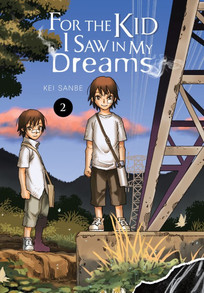Review
by Rebecca Silverman,For the Kid I Saw in My Dreams
GN 2
| Synopsis: |  |
||
Senri's spent years amassing money through shady practices in order to fund his revenge against the man who killed his parents and twin brother, but getting careless costs him not only his scam, but all of his funds. Senri's willing to give up on his revenge, however, even as it becomes increasingly clear to Enan and his grandparents that something is terribly wrong. Is living for revenge worth it if you have no plans to keep on living after it's all done? |
|||
| Review: | |||
Even if there wasn't an interesting mystery and emotional narrative to go with it, the way that Kei Sanbe has planned out this volume of For the Kid I Saw in My Dreams is truly impressive. The book opens with a prolonged flashback about Senri and Kazuto finding an abandoned car and making it their secret base before undertaking a journey to a distant tower just to see if they can. The boys are only five at the time, and they do it knowing full well that they'll get punished for coming home late as a result – if they make it home at all. Although it is never said, there's an implication that perhaps things would have been better if they never did. For much of the volume, this just seems like a normal flashback, Senri replaying in his mind the better days when the twins were together and there were better possibilities before them. However it later turns out to be a clever bit of foreshadowing, as Senri, trying to reconcile the words of Enan, his grandfather, and a yakuza he meets and tells about his goals, makes what is essentially a pilgrimage back to the car, tower, and his childhood home. Answers, he seems to feel, must be just beyond his fingertips, and this is the only way he can come up with to try to reach them. It's another step in the journey that we watched him begin in the previous volume. In that book we saw Senri go from shy younger twin to sole survivor of a brutal crime, which in turn caused him to retreat inside his shell, less like a turtle and more in the vein of a hermit crab, ready to hurt anyone with one oversized claw if they try to get too close. Essentially he was just waving that claw at the world, pinching when he could as he single-mindedly pursued revenge; if he still had vulnerabilities, we certainly didn't get to see them very much. This time, however, Senri is forced to really look at who he has become. When his extortion plot went south at the end of the previous book, Senri found himself at the mercy of the son of a high-ranked yakuza leader, and this time he's informed that it's essentially his money or his friend's life. In this moment, Senri has to actually recognize what he's been doing and think about its worth. Does he really value vengeance over someone's life? This seems to be the moment when Senri starts to wake up to who he's become. He's spent so long being obsessed with the loss of Kazuto that he's never stopped to think about what it's doing to him, although hints of the kinder person he used to be are still there. Nothing is really set to change, however, until three separate people point out to him that not only is he not planning to have a future, he also doesn't appear to be happy with how his life is now. Basically Senri is living in a hellish past and is unable to move on, and he's the only one who can really make the decision to change that. This is where another particularly strong bit of design for the volume specifically and the story in general comes in. Senri has a habit of throwing “scissors,” the move he didn't make all those years ago in the game that led to Kazuto being taken, whenever he's in front of a mirror. He's had this habit since he and Enan were at the group home together, explaining it as him trying to go back in time so that he was the one who won the game and Kazuto got away. What he's describing is survivor's guilt, and while this isn't the first time we've understood that he suffers from it, it is the moment when he himself admits it more fully, and perhaps marks Enan understanding what he's going through. For him that last game of rock, paper, scissors is the moment when he could have changed the outcome; since he didn't, all that's left is revenge. How that comes back to either haunt or absolve him is shown in moment by a mirror that reveals that perhaps vengeance isn't required after all. The tight plotting and clear thought that goes into this series, and particularly this volume, makes it an interesting read for mystery fans; the skill with which it is done just makes it a good story. It's different enough from Sanbe's previous work Erased that even if that one didn't work for you, this is worth taking a chance on. |
| Grade: | |||
|
Overall : A-
Story : A-
Art : B
+ Thoughtfully executed, good use of themes and literary techniques |
|||
| Production Info: | ||
|
Full encyclopedia details about Release information about |
||